Laptop Mag Verdict
The most well-rounded 13-inch notebook gets a serious speed boost and lasts even longer on a charge than its predecessor.
Pros
- +
Superb battery life
- +
Fast overall performance
- +
Sturdy, luxurious design
- +
Excellent keyboard and touchpad
- +
Robust software package
Cons
- -
Less graphics performance than predecessor
- -
Lower resolution than 13-inch MacBook Air
- -
Bottom torward the rear gets very warm
Why you can trust Laptop Mag
Apple has two strong 13-inch notebooks to entice shoppers, and one of them just got a lot stronger. While the 13-inch MacBook Air ($1,299) emphasizes portability and instant gratificaiton via Flash memory, the new 13-inch MacBook Pro ($1,199) is all about speed and extra-long endurance. The latest version boasts a bevy of new components and abilities, including a second-generation Intel Core i5 processor, a FaceTime HD webcam, and Thunderbolt high-speed connectivity. The much-loved unibody aluminum chassis remains, along with the outstanding backlit keyboard and glass touchpad, all for the same price. So how much better is this 13-inch MacBook Pro than its predecessor, and what do you give up?
Design
The 2011 13-inch MacBook Pro is virtually identical to its predecessor. Slim with its iconic curved lid, the aluminium unibody chassis exudes premium build quality from all angles. Measuring 12.8 x 8.9 x 1 inches, and weighing 4.6 pounds, the new machine has the same dimensions as before but is a fraction heavier (0.2 pounds). Of course, the 13-inch MacBook Air (0.7 inches thick, 2.9 pounds) makes the Pro look heavy by comparison, but this 13-incher still slips into bags easily and is relatively easy to carry.
Users will also find the same black Island-style keyboard and large multitouch touchpad that have graced previous models. Chiseled from a single block of metal, the MacBook Pro feels extremely sturdy. One drawback is that the MacBook Pro's battery is not replaceable, at least not without Apple tech support. Also, the chassis can scratch easily if exposed to sharp objects, making a custom-fit cover a smart investment.
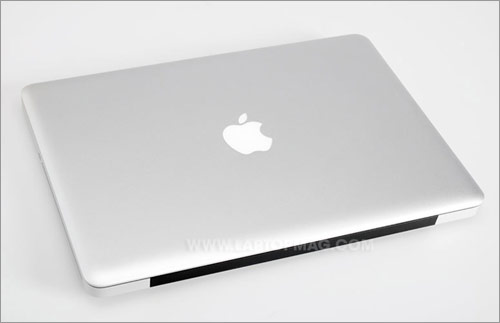
Click to enlarge
Heat
Despite its metallic construction, the MacBook Pro mainly kept its cool on our heat tests. After playing a Hulu video at full screen for 15 minutes, we measured a temperature of 90 degrees Fahrenheit at the center of the keyboard, while the notebook's underside returned the same reading. The touchpad was cooler at 80 degrees. The bottom back end of the 13-inch MacBook Pro did get toasty, logging a temperature of 109 degrees; we consider anything over 100 degrees cause for concern.
Keyboard and Touchpad
Folks familiar with the MacBook Pro know that its keyboard is one of the best around. The laptop's big square keys have a soft finish and are arranged in an island-style setup, offering plenty of spacing. They also make little sound when hit, yet provide a satisfying click. Equipped with an ambient light sensor, the keyboard is backlit as well, one of the advantages the 13-inch MacBook Pro has over the 13-inch Air.
Like MacBook Pros before it, the current version has a vast 4.1 x 3-inch touchpad that doubles as one massive button. Frankly, it's the gold standard; it let us glide our fingers across it with minimal friction and intuitively press down to make selections. We never missed the lack of a discrete mouse button, or even two.
The full gamut of familiar multitouch gestures are here as well. We easily used two fingers to scroll up and down through webpages and zoom in and out of photos and documents. With four digits we pushed all windows out of the way for a clear view of the desktop, and with three fingers swiped our way from app to app.
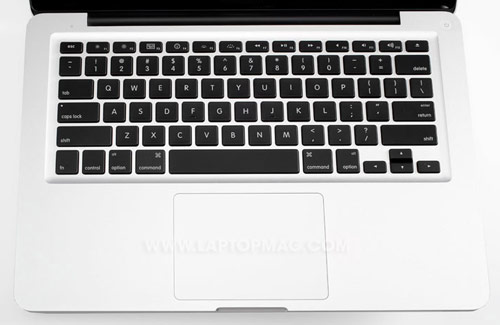
Click to enlarge
Display and Audio
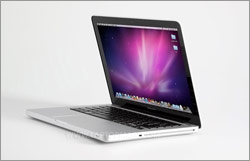
Click to enlargeThis MacBook Pro's 13.3-inch display serves up a resolution of 1280 x 800 pixels, and it gets very bright. We wish, though, that it had the same 1440 x 900-pixel resolution as the 13-inch MacBook Air. While watching Hulu episodes of Fringe and 30 Rock, colors were pleasantly saturated with rich, deep blacks. Unfortunately, the screen's glossy surface is prone to reflections, so viewing video in darker environments is advised. Viewing angles are also average, with image quality dropping off as we tilted the display off-center forward or moved side to side.
Audio through the MacBook's stereo speakers was definitely loud when playing "Living In America" by Dom using Slacker, but bass was certainly lacking. Even so, highs and vocals were clear and we found fidelity to be quite good.
Thunderbolt and Ports
New to the 13-inch MacBook Pro is Intel's Thunderbolt technology, formerly known as Light Peak. Occupying the same physical connection as the DisplayPort (which now has a lightning bolt icon next to it), ThunderBolt offers a theoretical throughput speed of 10 Gbps. The port is also able to power peripherals such as external hard drives without the aid of an additional electricity source, since it can carry up to 10 watts of juice.
The new connection will also allow users to daisy-chain up to six devices, meaning you could connect a large monitor along with multiple high-speed hard drives. That's sure to please video editors. No peripherals exist yet that use ThunderBolt, but products are expected to arrive this summer. Apple has demonstrated a 4.42GB folder being copied in about 10 seconds, a blazing data rate of 452.6 MBps.

Click to enlarge
Besides Thunderbolt, the 13-inch MacBook Pro's port spread remains the same as on prior versions. Along the left edge are two USB ports, a fast FireWire 800 connection for quick system backups (using Time Machine), and an SD card slot. There's also Ethernet, headphone, and slick magnetic power jack (called MagSafe), which will keep the MacBook Pro from flying off your desk if someone trips over the power cord. On the laptop's left sits the slot-loading DVD burner and a Kensington lock slot.
FaceTime and HD Camera
Thanks to a new FaceTime HD camera, the new 13-inch MacBook Pro now supports 720p HD video calls. Couple the cam with a newly installed FaceTime app that first debuted on the iPhone 4, and you've got a powerful video chat tool. In our tests, we called someone who was using the new 15-inch MacBook Pro over FaceTime and noted bright, life-like colors. Image quality was also sharp and motion was smooth. Defaulting to portrait mode, FaceTime can be flipped over to landscape view or full screen. Keep in mind that the app will only transmit a hi-def video stream if hardware on the other end can handle it.
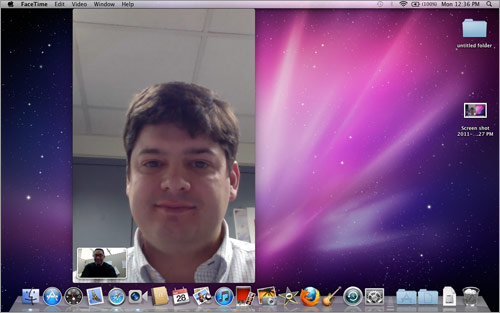
Click to enlarge
Performance
Under the 13-inch MacBook Pro's hood is a 2.3GHz Core i5 CPU--a big improvement over last year's Core 2 Duo chip--and 4GB of RAM. As a result we saw much better performance on our benchmark tests. The new 13-inch MacBook Pro turned in 5,534 on PCMark Vantage, a boost of almost 1,400 points. That's also 643 points higher than the current average for thin-and-light notebooks, and enough to best the Asus U36Jc (5,008, 2.53-GHz Core i5-460M CPU) and Sony VAIO S (4,950, 2.26-GHz Intel Core i5-430M CPU). Still, the MacBook couldn't stand up to the HP Envy 14 (6,129, 2.4-GHz Intel Core i5-470), which has AMD graphics. The MacBook Pro's GeekBench score of 6,446 is a 35 percent increase over the previous model (4,164), and more than double the 13-inch MacBook Air, whose 1.86-GHz Core 2 Duo processor mustered 2,976.
Running Snow Leopard, the 13-inch MacBook Pro booted in a quick 41 seconds, 24 seconds faster than the current category average, which consists mostly of Windows PCs. Still, the 13-inch MacBook Air starts up in less than 15 seconds, thanks to its flash memory. The 320GB, 5,400-rpm hard drive achieved a file transfer speed of 28.1 MBps, 3 MBps higher than the thin-and-light average, but a hair below the 29.1 MBps rate the previous MacBook Pro managed.
The 13-inch MacBook Pro took just 47 seconds to transcode a 5-minute MPEG-4 file to AVI using Oxelon Media Encoder in Windows (using BootCamp). The average thin-and-light takes about 15 seconds longer to complete this task. The MacBook Pro also crunched a 5-minute 1080p HD video file down to iPod Touch format using MediaEspresso in just 27 seconds, one of the fastest times we've seen.
Graphics
Apple decided to the replace Nvidia GeForce 320M graphics in the previous 13-inch MacBook Pro with an integrated Intel HD 3000 chip. The result was a 3DMark06 score of 4,509, which is 245 points lower than last year's model. Even so, the MBP's showing is well above the current thin-and-light average of 3,069. It also trumped other 13-inch notebooks, such as the Asus U36Jc (3,518 with GeForce 310M). Of course, compared to HP Envy 14 (6,876 with ATI Mobility Radeon HD 5650), the 13-inch MacBook Pro doesn't measure up. You'll want to step up to the 15-inch MacBook Pro if you want serious graphics muscle.
Similarly, this MacBook Pro 13-inch couldn't match its predecessor on our gaming tests, with the notebook managing 21 fps playing Far Cry 2 at optimal settings and at 1024 x 768 resolution, where last year's MBP scored 47 fps. Things got worse at native resolution (1280 x 800) with the new 13-inch MacBook coughing up just 13 fps, less than the previous MacBook Pro's 19 fps. By comparison, the Asus U33JC scored 22 fps at 1024 x 768. The HP Envy 14 scored 75 fps at 1024 x 768 and 27 fps at a higher 1600 x 900 native resolution.
Results improved in World of Warcraft, with the MacBook Pro achieving a fair 74 fps at 1280 x 800 while in autodetect mode. The system squeezed out 28 fps with all the game's effects set to maximum. Both scores are somewhat below the category averages (99.3 fps and 31.5 fps, respectively) but will still provide a good gaming experience.
With its discrete graphics, the previous MacBook Pro 13-inch notched a higher 124 fps and 50 fps, respectively, although to be fair, WOW has become more graphically demanding with its latest update. The 13-inch MacBook Air, which also has Nvidia 320M graphics, averaged 17 fps at its native resolution and max settings.
Battery Life
We were very pleased when last year's 13-inch MacBook Pro achieved a very long runtime of 7:48, but the new version lasts even longer on a charge. The notebook persevered for a marathon-like 8:33 on our LAPTOP Battery Test (web surfing via Wi-Fi). That's about three and a half hours longer than the current thin-and-light average, and beats the Asus U36Jc (6:24), Alienware M11x (7:14), and HP Envy 14 (4:26). It also outperforms Apple's stated battery life of 7 hours. It even bested the 13-inch MacBook Air by two hours.
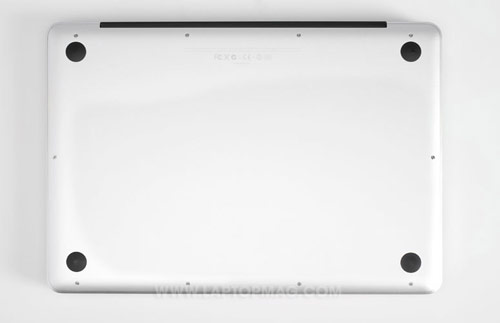
Click to enlarge
Long battery life is even more of a positive considering you can't swap out a new battery on the fly as you can with most other laptops. Apple says the MacBook Pro's Lithium Polymer battery is good for 1,000 charges (roughly 3 years depending on usage). Springing for a new battery will cost $129 and can be installed in Apple stores or by mailing the entire laptop in for service. Considering that most notebook batteries cost around the same price and wear out after a couple of years, the only disadvantage here is that you can't replace the unit yourself.
Software and Warranty
Apple offers perhaps the best software bundle in the industry. In addition to the Snow Leopard operating system, the MacBook Pro comes with the excellent iLife ‘11 suite (iPhoto, iMovie, iWeb, and GarageBand), Front Row, Photo Booth, and the Time Machine backup software. We just wish there was a word processor pre-installed that offered a few more abilities than TextEdit; the the iWork suite costs $49 extra. If you want to shop for programs, the Mac App Store makes it easy to find what you're looking for and install with a single click.
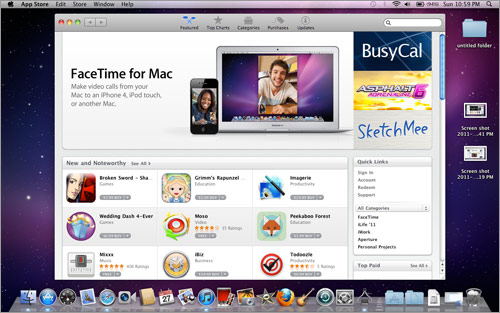
Click to enlarge
Apple provides the same standard warranty coverage as previous MacBook Pros: one-year parts and labor and 90 days of toll-free, 24/7 phone support. The Apple Care Protection Plan, which includes three years each of parts-and-labor coverage and phone support, costs $249. See how Apple fared in our Tech Support Showdown, click.
Configurations
In addition to the $1,199 base configuration we reviewed, consumers can also upgrade to a $1,499 version, which has a faster 2.7-GHz Intel Core i7 processor, 4GB of RAM, and a larger 500GB hard drive. Customization options include 8GB of RAM ($200), mechanical hard drives up to 750GB in size ($150), or solid-state drives ranging from 128GB ($250) to 256GB ($650) to 512GB ($1,250).
Verdict
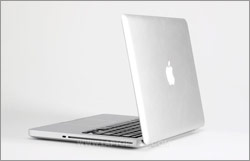
Click to enlargeApple has once again created a winning notebook. The 13-inch MacBook Pro is considerably faster than its predecessor yet lasts over 8 hours on a charge. We also like the new FaceTime HD camera and look forward to seeing Thunderbolt-enabled peripherals that take advantage of the new port. Gamers and other users who want more graphics power will want to look elsewhere. And the 13-inch MacBook Air offers a higher-resolution display in a much thinner and lighter package. But if you have a need for speed and epic endurance, the 13-inch MacBook Pro will definitely satisfy.
Apple MacBook Pro 13-inch (2011) Specs
| Bluetooth | Bluetooth 2.1 EDR |
| Brand | Apple |
| CPU | 2.3GHz Intel Core i5 |
| Card Slots | SD/MMC memory reader |
| Company Website | http://www.apple.com |
| Display Size | 13.3 |
| Graphics Card | Intel HD Graphics 3000 |
| Hard Drive Size | 320GB |
| Hard Drive Speed | 5,400rpm |
| Hard Drive Type | SATA Hard Drive |
| Native Resolution | 1280x800 |
| Operating System | OS X 10.6 (Snow Leopard) |
| Optical Drive | DVDRW SuperDrive |
| Optical Drive Speed | 8X |
| Ports (excluding USB) | security lock slot, Headphone, Firewire 800, Ethernet, Thunderbolt/mini DisplayPort |
| RAM | 4GB |
| RAM Upgradable to | 8GB |
| Size | 12.8 x 8.9 x 1 inches |
| Touchpad Size | 4.1 x 3.0 inches |
| USB Ports | 2 |
| Video Memory | 384MB |
| Warranty/Support | 1 year limited warranty with 90 days of toll-free technical support. AppleCare costs $249 and adds 2 years of support covering parts and labor. |
| Weight | 4.6 pounds |
| Wi-Fi | 802.11a/b/g/draft-n |
| Wi-Fi Model | Broadcom |
